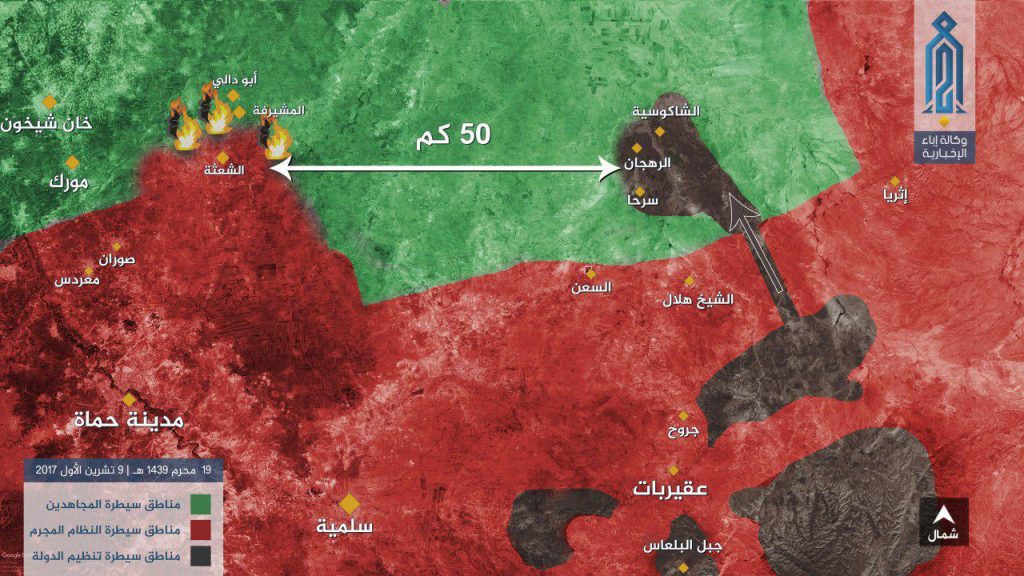
Hay’at Tahrir al Sham (“Assembly for the Liberation of Syria”) released this map showing the proximity of its battles against the Assad regime (left) and the Islamic State (right).
The Islamic State has launched a new offensive against Hay’at Tahrir al Sham (HTS), the self-declared caliphate’s longtime jihadist rival, in Hama province. Abu Bakr al Baghdadi’s men attacked HTS in eastern Hama province, capturing several villages in the process.
The battle is part of the Islamic State’s “Abu Muhammad al Adnani” campaign, which was named for the group’s fallen spokesman and leader. Much of the offensive has been focused on Bashar al Assad’s regime, as well as its Russian and Iranian backers, in central and eastern Syria.
The Russians and the Iranians have played a key role in propping up Assad’s forces, including during their push into eastern Syria this past summer. But Assad’s allies have also suffered some high-profile casualties during the campaign. For example, Lt. Gen. Valery Asapov was killed during shelling by the Islamic State near the city of Deir Ezzor late last month.
Sometime during the last day, Baghdadi’s loyalists turned their guns and armored vehicles on HTS in Hama province.
HTS quickly released a statement denouncing the assault and accusing the Assad regime of allowing the Islamic State’s jihadists to pass through its territory into HTS-controlled Hama. This is a common argument employed by various actors on the ground in Syria, where enemies and rivals frequently accuse each other of being in cahoots with Assad’s forces. The reality is that both the so-called caliphate and HTS frequently clash with the Syrian government and its sponsor. The battlefield is messy and chaotic, with all sides regularly making tactical adjustments and compromises.
Since the rise of the Islamic State in 2013 and 2014, Baghdadi’s subordinates have frequently clashed with their jihadist rivals. The infighting began when Al Nusrah Front and its emir, Abu Muhammad al Julani, refused to obey Baghdadi’s orders in Syria. The infighting that followed led to numerous deaths on both sides. The Islamic State has continued to clash with Julani’s men, even after his organization changed its name twice in less than a year. Al Nusrah formed the backbone of HTS in January, but has suffered from a variety of problems since then. The so-called caliphate, which has lost most of the territory once under its control, has repeatedly attempted to seize ground from HTS in Damascus and elsewhere.
Earlier this year, HTS claimed to have uncovered a number of Islamic State cells operating throughout Idlib province, the organization’s stronghold.
The Islamic State’s most recent assault on HTS came just days after HTS launched its own offensive on Assad’s men in Hama. HTS targeted the village of Abu Dali, which sits at a crossroads between the provinces of Idlib and Hama. Via its Ebaa News Agency, HTS has advertised its gains in and around Abu Dali. The photos show captured vehicles, including a tank, and other arms, as well as the corpses of pro-Assad fighters scattered on the ground.
One map produced by Ebaa News (shown above) illustrates the close geographic proximity of the two battles HTS is fighting: one against the Islamic State and the other against the Assad regime and its allies.








1 Comment
ISIS fighting al Qaeda again. How very sad…